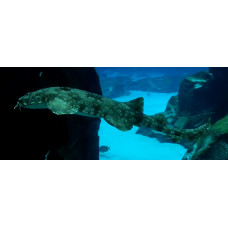Latin name
Orectolobus maculatus
Other name
Orectolobus maculatus
Identification
The Spotted Wobbegong has a flattened and broad head and body. The nostrils are framed by branched antennae consisting of two lobes and grooves connecting them to the mouth. Below and in front of the eyes are 6-10 skin lobes forming a fringe. The fringe lobes behind the spiracles are broad and branched. There are no tubercles or protuberances on the dorsal surface.
Features of fish fins
The base of the first dorsal fin begins at the level of the posterior third of the bases of the pelvic fins. The distance between the dorsal fins exceeds the length of the inner margin of the first dorsal fin and is almost twice the length of its base. The height of the first dorsal fin is nearly equal to the length of its base. The caudal fin is asymmetrical, with a ventral notch on the edge of the upper lobe. The lower lobe is absent.
Fish colouring
The coloration is very variegated, darker and less contrasting than other wobbegongs except Orectolobus wardi. The body is covered with dark saddle-shaped markings surrounded by lighter rings and spots. Their variegated coloration and skin fringe provide excellent camouflage on uneven bottoms, but they are clearly visible on sand.
Distribution
These sharks appear to be endemic to the southern coast of Australia and are found in temperate and subtropical waters on the continental shelf from Gladstone south to Hobson's Bay and Victoria, St. Vincent Bay, off the coast of South and East Australia.
Habitat
Spotted Wobbegong are found offshore and inshore on coral and rocky reefs, in bays, estuaries, under piers, and on sandy bottoms from the surf zone to 218 meters. Juveniles are more likely to be found in estuaries and seagrass beds. Spotted Wobbegong have been observed crawling from one tide pool to another in shallow water when the water barely covers their backs.
Size
The maximum recorded length is 320 cm, but the average size is 150-180 cm. Newborns are 21 cm long. Males reach sexual maturity at a length of 60 cm.
Behavior
These slow and inactive sharks are often seen lying motionless on the bottom, at least during the day. During the day they hide in caves, crevices under rocky reefs and shipwrecks. These sharks have a limited individual home range with several frequently used hiding places. Spotted Wobbegong are found both individually and in groups of up to 12 individuals. They are nocturnal and emerge from their hiding places as darkness falls and begin to swim and scramble along the bottom in search of food.
Food and feeding habits
Their diet consists of benthic invertebrates such as crabs, lobsters and octopuses, as well as bony fish such as Serranidae, Scorpaenidae and Kyphosidae, sharks including congeners, and rays. The wobbegongs wide, short mouth and large, voluminous throat are adapted to suck in prey. There is reason to believe that wobbegong suddenly suck food into their mouths by expanding their pharynx while the prey is in front of them. The powerful jaws, modified symphyseal anterior teeth, and one medial and two lateral rows of mandibular teeth, interlocked with two rows of large maxillary teeth, form an effective trap that pierces and kills the prey.
Reproduction
Orectolobus maculatus reproduces by oviparity. The litter is numerous, reaching 37 newborns. During mating, the males are aggressive towards each other, and during copulation the male bites the female in the area of the gills. In captivity, they mate in July. An experiment was conducted in which a female placed in a fenced enclosure in the sea during the breeding season attracted a wild male who attempted to enter the enclosure. It was concluded that the female was emitting some stimuli, possibly pheromones.
Fishing
This species is of interest to commercial fisheries. These sharks are caught as by-catch in gillnets, trawls, set gillnets, triangle nets, lobster traps. Spotted Wobbegong are sometimes hunted with underwater guns.
Relationship with a person
Spotted wobbegong pose some danger to humans. They have been known to bite people who have stepped on them, as well as to actively resist and cause injury when caught in a net or hook or shot with an underwater gun. They can also bite a person on a limb in front of the mouth. Their powerful jaws can cause serious injury. There have been 23 recorded attacks on humans by sharks of this species.
The meat of these sharks is used for food and the skin is used to make high quality leather with a beautiful pattern.
Orectolobus maculatus is kept in public aquariums in Europe, USA and Australia.
| Classification | |
| Phylum | Chordata |
| Class | Chondrichthyes |
| Squad | Orectolobiformes |
| Family | Orectolobidae |
| Genus | Orectolobus |
| Species | O. maculatus |
| Features | |
| Conservation status | Least Concern |
| Habitat | Pelagic |
| Life span, years | No information |
| Maximum body weight, kg | No information |
| Maximum length, cm | 320 |
| Sailing speed, m/s | No information |
| Threat to people | Edible |
| Way of eating | Predator |
Spotted wobbegong
Tags: spotted wobbegong



